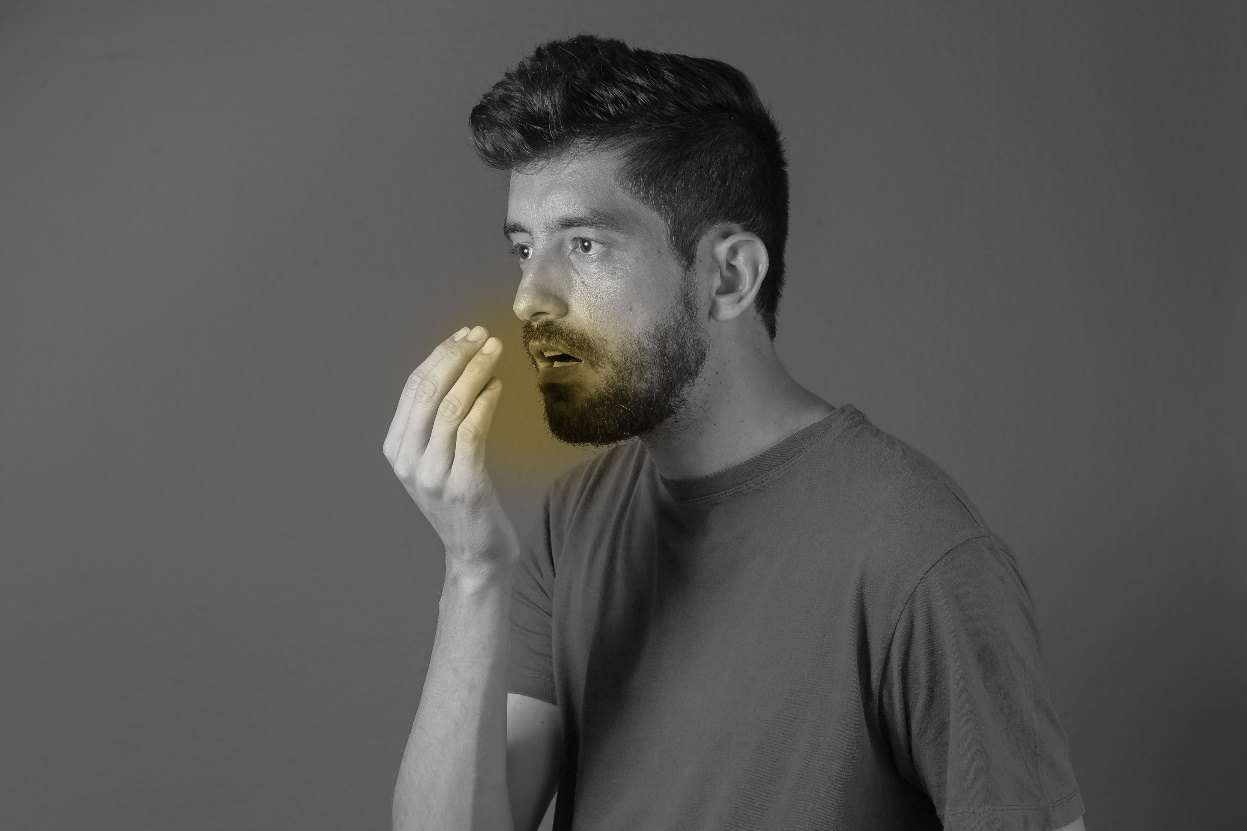Bad breath, also called halitosis, can be embarrassing and in some cases may even cause anxiety. It’s no wonder that store shelves are overflowing with gum, mints, mouthwashes, and other products designed to fight bad breath. But many of these products are only temporary measures because they don’t address the cause of the problem.
Certain foods, health conditions, and habits are among the causes of bad breath. In many cases, you can improve bad breath with consistent proper dental hygiene. If simple self-care techniques don’t solve the problem, see your dentist or physician to be sure a more serious condition isn’t causing your bad breath.
Symptoms :
Bad breath odours vary, depending on the source or the underlying cause. Some people worry too much about their breath even though they have little or no mouth odour, while others have bad breath and don’t know it. Because it’s difficult to assess how your own breath smells, ask a close friend or relative to confirm your bad-breath questions.
Causes :
Most bad breath starts in your mouth, and there are many possible causes. They include:
Food – The breakdown of food particles in and around your teeth can increase bacteria and cause a foul odour. Eating certain foods, such as onions, garlic, and spices, also can cause bad breath. After you digest these foods, they enter your bloodstream, are carried to your lungs, and affect your breath.
Tobacco products – Smoking causes its own unpleasant mouth odour. Smokers and oral tobacco users are also more likely to have gum disease, another source of bad breath.
Poor dental hygiene – If you don’t brush and floss daily, food particles remain in your mouth, causing bad breath. A colourless, sticky film of bacteria (plaque) forms on your teeth. If not brushed away, plaque can irritate your gums and eventually form plaque-filled pockets between your teeth and gums (periodontitis). Your tongue also can trap bacteria that produce odours. Dentures that aren’t cleaned regularly or don’t fit properly can harbour odour-causing bacteria and food particles.
Dry mouth – Saliva helps cleanse your mouth, removing particles that cause bad odours. A condition called dry mouth or xerostomia can contribute to bad breath because the production of saliva is decreased. Dry mouth naturally occurs during sleep, leading to “morning breath,” and it worsens if you sleep with your mouth open. Chronic dry mouth can be caused by a problem with your salivary glands and some diseases.
Medications – Some medications can indirectly produce bad breath by contributing to dry mouth. Others can be broken down in the body to release chemicals that can be carried on your breath.
Infections in your mouth – Bad breath can be caused by surgical wounds after oral surgery, such as tooth removal, or as a result of tooth decay, gum disease, or mouth sores.
Other mouths, nose, and throat conditions – Bad breath can occasionally stem from small stones that form in the tonsils and are covered with bacteria that produce odour. Infections or chronic inflammation in the nose, sinuses, or throat, which can contribute to postnasal drip, also can cause bad breath.
Other causes – Diseases, such as some cancers, and conditions such as metabolic disorders, can cause a distinctive breath odour as a result of the chemicals they produce. Chronic reflux of stomach acids (gastroesophageal reflux disease, or GERD) can be associated with bad breath. Bad breath in young children can be caused by a foreign body, such as a piece of food, lodged in a nostril.
How to get rid of bad breath?
Bad breath can be cured by oral prophylaxis done by the dentist. Oral prophylaxis is a thorough examination of your oral health combined with a scale and clean and can be conducted by a dentist or a dental hygienist.
The examination consists of various components:
- Update of medical history. One of the most important things about oral prophylaxis is to update your history and compare it against your records. This will help the dentist determine if further action or examination is required.
- Dental X-Rays. Digital dental X-rays are taken of your mouth to get an up-to-date picture of what’s going on below the surface. It can help to reveal problems with teeth and bone, such as monitoring the progress of wisdom teeth that may cause complications. Depending on your oral health history, you may get these during every visit, or only every other visit.
- Periodontal probing. There is a small gap between your gums and teeth at the gum line. In healthy teeth, this gap is very shallow. In infected teeth with gingivitis or periodontitis, however, this gap forms into a pocket measuring several millimetres in depth. You will have this gap checked to see how deep it is, and whether there is any reason to suspect a problem.
- Oral cancer check. It’s more and more common for an oral cancer check to be performed as part of oral prophylaxis which is done at every visit.
A “scale and clean” involves removing plaque and tartar from the teeth, then polishing the teeth. This is often finished with a fluoride mouthwash to help strengthen the teeth.
Scaling is the act of removing tartar, also known as calculus, from the teeth. During regular dental prophylaxis, this is performed with specialized scraping tools to remove the hardened build-ups. Ultrasonic tools may be used, but typically these aren’t necessary for the small build-ups experienced in a regular clean.
Polishing the teeth is done to remove plaque, a sticky film-like substance that acts as a precursor to tartar. A common method of polishing teeth today is to use what is known as a Prophy Jet. This is an air-powder polishing unit that combines air, water, and fine powder to polish teeth. Plaque is removed from the surface which is then smoothed down by the jet to prevent plaque from having anything to hold onto when it starts to regrow.
What will be the cost of the treatment?
This treatment needs deep cleaning of gum tissue called as Phase-1 therapy (non-surgical periodontal treatment) charges vary from 2.5k to 4.5k per 6 teeth.
| OUR CLINICAL WORK – NON-SURGICAL THERAPY | |
| Before – 1 | After – 1 |


